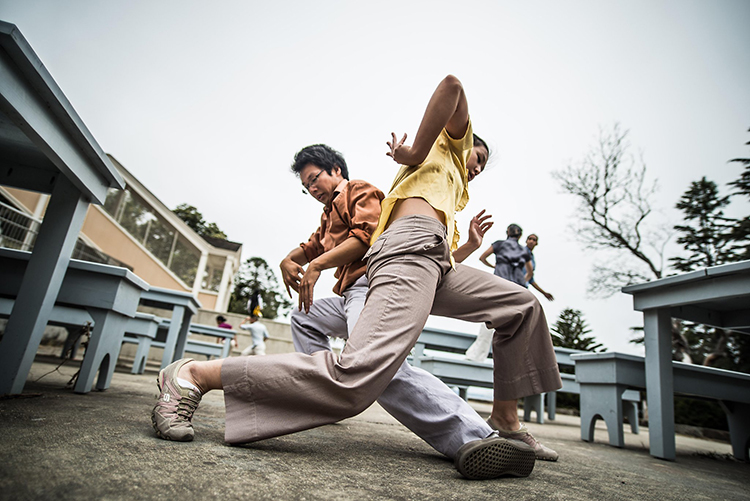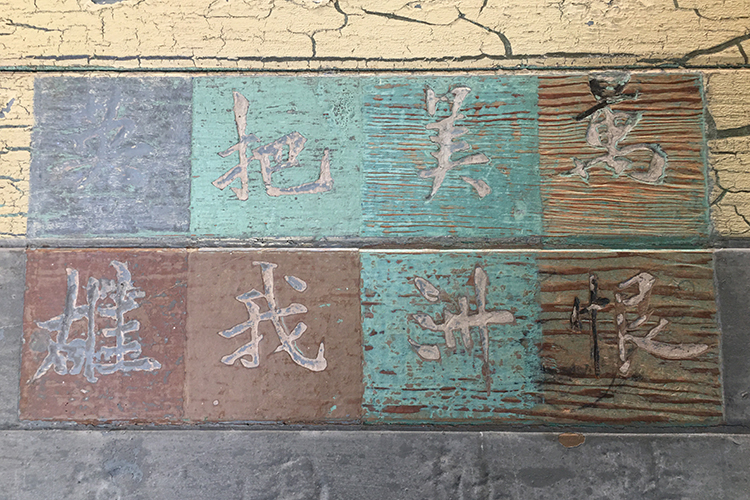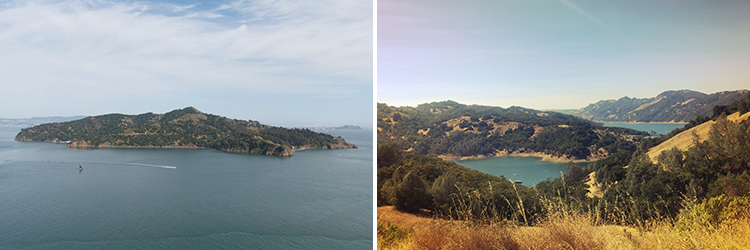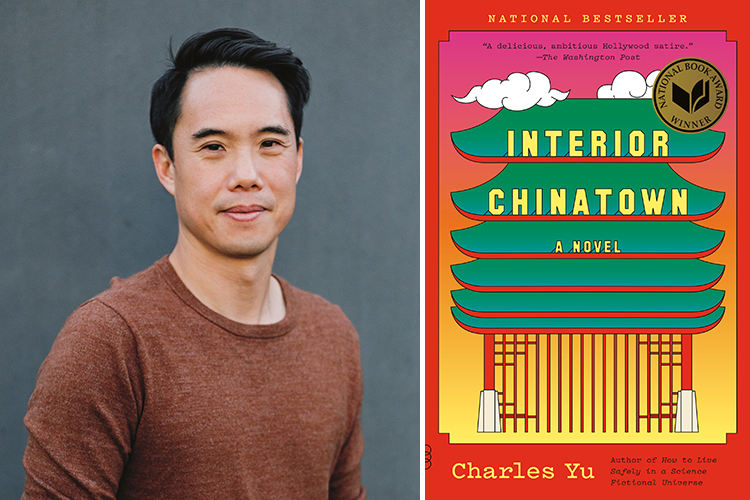Angel Island arts project explores immigration, architectures of incarceration
The yearlong, campuswide project is sponsoring a series of music and dance performances, exhibitions and public conversations

September 7, 2022
On a sunny afternoon in November 2020, in front of Sweet Adeline Bakery in south Berkeley, UC Berkeley staffer Susan Moffat came upon a string quartet.
“Their playing was spectacular,” she said.
The musicians were members of the award-winning, San Francisco-based chamber ensemble Del Sol String Quartet. They’d recently launched the Joy Project, for which they’d commissioned a body of short musical works written to give joy during the pandemic and were performing free concerts in public spaces all around the Bay Area.
“It was during the depths of the pandemic,” Moffat said, “and hearing live music was not just a pleasure, but a kind of medicine.”
Moffat, creative director of Berkeley’s Future Histories Lab, learned the performers were also using music to explore darker issues: They had commissioned an oratorio from composer Huang Ruo about San Francisco Bay’s Angel Island, the site of a historic U.S. immigration station, in operation from 1910 to 1940, where Chinese immigrants and others were incarcerated in detention barracks, sometimes for years, in harsh conditions as they waited to be processed.
Del Sol premiered Angel Island — Oratorio for Voices and Strings in the detention barracks on Angel Island in October 2021. The audience of several hundred people sat in chairs in a room where immigrants had once been incarcerated in crowded bunks stacked three beds high.
“It was an incredibly moving piece,” said Moffat. “I thought, ‘We have to bring this to UC Berkeley somehow.’ I never would have guessed that this chance encounter would lead to a campuswide, interdisciplinary arts and public history project on immigration.”
Hidden on the walls was poetry
In 1970, a California State Park ranger named Alexander Weiss was walking around Angel Island, which had been in the possession of California State Parks since 1955.
As Weiss shined his flashlight into the abandoned detention barracks, he noticed something: Hidden by layers of paint was writing in Chinese characters, elegant brush strokes carved into the old wooden walls.
But Weiss didn’t know what the writing meant. So, he turned to the local Asian American community to help figure it out. Scholars analyzed the writing and determined it was poetry, written and carved into the walls by detainees held there decades before.
“The poems are beautifully done,” said Elizabeth Fair, a fourth-year Ph.D. student in the history of art at Berkeley. “It looks like they’re sort of brushed on and then carved out — the carving mimics the tapering and widening of the brush strokes. So, they’re really sort of formal inscriptions with a recognizable calligraphy style.”

More than 200 Chinese poems are carved into the wooden walls of the former detention barracks on Angel Island. Scholars and Berkeley alumni Judy Yung and Him Mark Lai collected and translated the poems that they, with Genny Lim, published in their 1991 book, Island: Poetry and History of Chinese Immigrants on Angel Island, 1910-1940. See a selection of poems and their translations that appear in the book. Angel Island was awarded the National Historic Landmark status by the National Register of Historic Places in 1997. (Photo by Susan Moffat)
The immigration station on Angel Island was built to enforce the Chinese Exclusion Act of 1882. The act was the first significant law restricting immigration into the U.S. and the first law to limit immigration based on race or nationality. It set a precedent for restrictive immigration in the country, and subsequent laws were passed to exclude people from other Asian countries.
The discovery of the poems came at a time when the fields of ethnic studies and Asian American studies, which evolved from the civil rights movement, were gaining ground in the Bay Area and across the country.
Because many of the detainees were so-called “paper sons,” or men immigrating to the U.S. with identity papers they purchased to circumvent the Chinese Exclusion Act by claiming family connections, they had been reluctant to share their immigration experiences with anyone, even their children.
“Angel Island became a very important site for people studying and reclaiming Chinese and Japanese American histories, which were also often their families’ histories,” Fair said.

Angel Island, the site of a U.S. immigration station from 1910-1940, is a little over one square mile. Immigrants held in the detention barracks on the island carved poetry into the walls about their views of the lush landscape through the bars of their windows. (Left: photo by Nathan Barteau via Unsplash; right: photo by Michelle Li via Unsplash)
In her research at Berkeley, Fair is exploring the concept of cultural heritage in California and how museums and monuments interact with that concept, especially with regard to transpacific immigration in the 20th century.
“I became very interested in the material, the spatial and environmental context of it,” she said.
Fair wondered: Why are the poems carved in the walls instead of painted? Is their placement on the walls important to the meaning of the poems? And how did the detainees interact with the poems and the architecture and the landscape, and use the windows and the views through the windows, to create an emotional effect?
The poems — more than 200 of them line the walls throughout the barracks — tell stories about the lives and families the immigrants left behind. Of being imprisoned, looking through torn curtains at the island’s lush landscape, surrounded by an expansive bay. Of deep loneliness, and of uncertainty and anxiety about their fate.
Fair worked as a park interpretive specialist on Angel Island from 2014 to 2016. When she was giving tours to visitors, she’d read them the translation of a poem written on a wall in the upstairs room:
I used to admire the land of the Flowery Flag as a country of abundance.
I immediately raised money and started my journey.
For over a month, I have experienced enough winds and waves.
Now on an extended sojourn in jail, I am subject to the ordeals of prison life.
I look up and see Oakland so close by.
I wish to go back to my motherland to carry the farmer’s hoe.
Discontent fills my belly and it is difficult for me to sleep.
I just write these few lines to express what is on my mind.
“I was with this group of people, and I had them think about the line, ‘I see Oakland so close by,’” Fair said.
“And, of course, if they look through the window, they can see Oakland. It’s right there. But they’re looking at it through a barred window. They’re experiencing a combination of the poem working, in its actual material presence, with the architecture of the building and the landscape around them. So, the poem is actually changing how they’re perceiving what they’re seeing.”
Listen to a selection of Angel Island poems read in Taishanese, a dialect of Yue Chinese native to Taishan, Guangdong.
Although the largest national group detained on Angel Island was Chinese, an estimated 300,000 incoming immigrants from 80 countries were processed at the station during the three decades it was open.
Fair remembers sitting in the Parks office on the island one day and overhearing visitors saying they didn’t want to go into the barracks because, “It’s not my history.”
But, Fair said, it’s all of our history.
“It’s deeply tied to how we think of ourselves as Americans, what American history actually is,” said Fair. “We have a very persistent narrative that America is a nation of immigrants, that it’s open to everyone to seek a better life. But the truth, as we know, is more complicated than that.”
The Angel Island project takes shape
After hearing the Angel Island oratorio, Moffat and Future Histories Lab moved quickly to bring the performance to UC Berkeley.
Future Histories Lab is part of the Mellon-funded Global Urban Humanities Initiative, started in 2013 by Jennifer Wolch, then the dean of the College of Environmental Design, and Anthony J. Cascardi, then the dean of Arts & Humanities. The initiative is currently led by Wolch and Sara Guyer, the current dean of Arts & Humanities.
Not only did Moffat want to bring the performance to the campus, but she also wanted to engage others working on related material in the arts and across academic disciplines.
“Angel Island’s immigration station is such a great starting point for thinking about othering and belonging and immigration,” Moffat said.
So, she got in touch with Lisa Wymore, faculty adviser of Berkeley Arts + Design and a professor in the Department of Theater, Dance and Performance Studies, who then decided to propose Within These Walls, a multimedia dance experience created by Lenora Lee Dance, as the spring 2023 Berkeley Dance Project.
The performance, inspired by the 170,000 Chinese immigrants detained on Angel Island, was first performed in 2017 inside the Angel Island detention barracks as part of a community-wide commemoration of the 135th anniversary of the Chinese Exclusion Act.
From there, a model for a larger campus project began to take shape.
Art is not just about individual expression. It’s a way of interacting with the world and understanding the experiences of others.
“We thought students should have a chance to dig in and really understand the roots of these works of art,” said Moffat. “So, we thought, ‘How can we provide curriculum or courses?’ And then we realized there are already so many existing, really wonderful courses on race and immigration and landscape and memory.”
Moffat and Wymore began to connect with faculty on campus and affiliate with existing courses exploring these themes. They engaged campus centers, including the Arts Research Center, the Berkeley Interdisciplinary Migration Initiative and the Center for Race and Gender, the Townsend Center for the Humanities and the Othering and Belonging Institute, as well as the Department of Art Practice’s Worth Ryder Art Gallery and the Berkeley Art Museum and Pacific Film Archive (BAMPFA).
They also partnered with the Angel Island Immigration Station Foundation, a San Francisco nonprofit that “raises awareness of the experience of immigration into America through the Pacific.”
From this expansive outreach effort grew a yearlong, campuswide project by Berkeley Arts+Design and Future Histories Lab: A Year on Angel Island: Immigration Histories and Futures.
The project is sponsoring a series of music and dance performances, exhibitions and public conversations, using Angel Island’s immigration station as a jumping-off point to start discussions about race, global migration and architectures of incarceration.
“It’s already deep in the fibers of the campus,” said Wymore. “This project is making the work visible and allows people to see our cross-connections, not only for ourselves, but for our students and community.”

A Year on Angel Island is a campuswide project sponsoring a series of campus performances, exhibitions and public conversations using Angel Island’s immigration station as a jumping-off point to start discussions about race, global migration and architectures of incarceration. It’s also affiliated with 25 different courses at Berkeley and with the program, On the Same Page.
Examining immigration and architectures of incarceration through art
This fall and spring, 25 affiliated courses are being offered across disciplines, from Humanities 20: Explorations in Art + Design at Berkeley, co-taught by Moffat and Wymore, to the Asian American Studies course, Asian American Communities and Race Relations, to a course in comparative literature, Memoir and Immigration.
A Friday speaker series, part of the Humanities 20 course, kicked off last week with a conversation between Greg Sarris, tribal leader of the Coast Miwok, the Indigenous people whose territory includes Angel Island, and Beth Piatote, an associate professor of comparative literature and English at Berkeley, about how literature and nature intersect with stories of Bay Area Native American history.
Also speaking are architectural historian Lynne Horiuchi, about the Manzanar concentration camp; curator and artist Julio Morales, on visual arts about incarceration; and writers of the new musical, Illegal, about the “paper son” ancestors of one of the playwrights. In addition, law professor Leti Volpp will invite scholars of legal and public health issues that connect to Angel Island history to speak in the spring about current concerns of anti-Asian racism and the incarceration of immigrants; and the Arts Research Center will present poetry about Angel Island. All talks are open to the public.
Angel Island — Oratorio for Voices and Strings is coming to Berkeley in December, this time performed by the Berkeley Chamber Chorus and conducted by Wei Cheng and the Del Sol Quartet. Anyone is welcome to attend the concert, which will take place in Hertz Hall on campus.

In December, the Berkeley Chamber Chorus, conducted by Wei Cheng and the Del Sol Quartet, will perform Angel Island — Oratorio for Voices and Strings in Hertz Hall on campus. (Photo by Brandon James Yung)
In February, students in the Berkeley Dance Project will restage Within These Walls, choreographed by Lenora Lee Dance and directed by SanSan Kwan, chair of the Department of Theater, Dance and Performance Studies. The performance will integrate original recorded music, poetry and video of the detention barracks of the Angel Island Immigration Station.
“Students will get to learn by the act of doing, by embodying characters that were built from real-life stories right from the island,” Wymore said. “It’s a very experiential mode of learning for our students that we feel the arts really excel at.”
A Townsend Center for the Humanities working group is open for students and faculty to join this fall. The working group will create public art exhibitions or performances to be presented at Angel Island this spring, in collaboration with the Angel Island Immigration Station Foundation and California State Parks.
And Berkeley ethnic studies professor Lok Siu will work with students, in collaboration with the Chinese Historical Society, this spring to create a digital history project about San Francisco Chinatown.
A Year on Angel Island public events
- Fridays at 11:30 a.m.: Landscapes of Migration, Incarceration and Resistance lecture series, Osher Theater at BAMPFA and livestreamed
- Dec. 3 at 8 p.m.: Angel Island Oratorio, Hertz Hall
- Feb. 23-26: Within These Walls, Zellerbach Playhouse
“Students won’t be passively sitting in a lecture hall,” Moffat said. “They’ll be producing new knowledge. Lisa and I, we think of art as a research method and a way of asking questions. Art is not just about individual expression. It’s a way of interacting with the world and understanding the experiences of others. The act of seeing a play or listening to music is one in which the listener is creating new knowledge within themselves.”
“Arts and humanities are essential for the work that needs to be done in this world by teaching people to think more carefully about positions and belief systems and to build empathy for others,” added Wymore.
Wymore and Moffat said they hope the project will be a model of new ways to connect faculty, students, staff, community members, artists and activists in the future. And Angel Island, with its rich history and its deep ties to American identity, is a perfect place to begin.
The poems of Angel Island live on
Almost all of the poems, carved with care into the walls of the detention barracks, are unsigned, and no author has ever been identified.
Although Fair can’t put herself directly in the immigrant detainees’ world, she said, the poems are a trace of their physical presence and a link to how they saw their own experience.
“It does feel like voices speaking to you, in some way,” she said. “It feels like you can almost grasp, for an instant, people moving through these rooms, spending months, weeks, in these rooms. I do feel, for a second, that I can see a new kind of landscape through their eyes.”
“Landscapes are places that both hide and illuminate history,” added Moffat. “And when we start walking with our eyes open, the landscape starts to speak to us.”
Learn more about the Angel Island Project.
Contact Susan Moffat at [email protected] with questions.